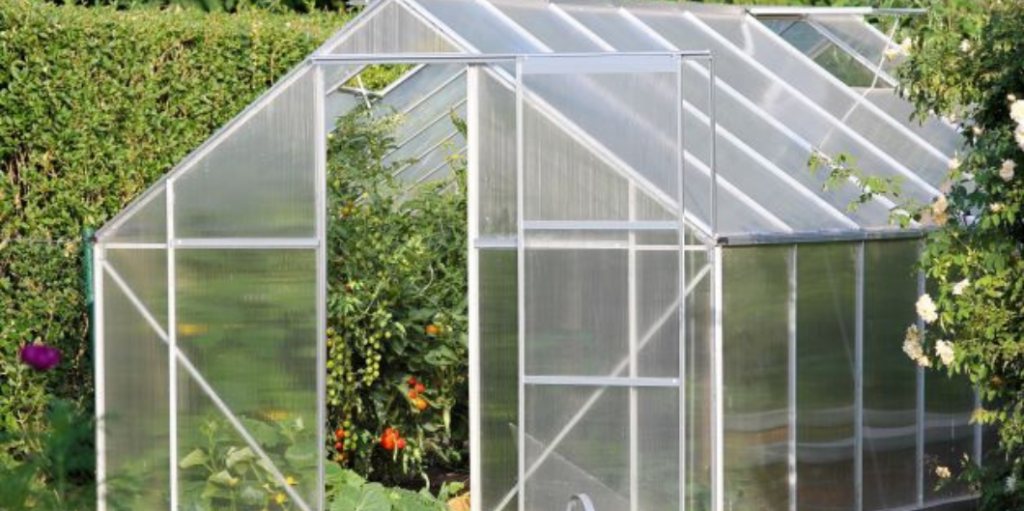Polycarbonate is a popular building material for both commercial operations and home improvement projects. It is lightweight and stiff, providing outstanding strength, flexibility, weather resistance, and light transmission. Polycarbonate is often used as a noncorrosive industrial structural roofing and siding solution since it can endure strong impacts and performs well throughout a wide temperature range.
Because of its light transmission and robustness, corrugated polycarbonate is a common material for greenhouses. It has a high life expectancy since it can tolerate harsh temperatures without degrading and won’t need to be replaced as frequently as other materials.
Polycarbonate comes in a variety of colors and can be utilized anywhere that requires an external light source. It’s also a popular material for outdoor shelters, gardening sheds, and storage structures because it provides a uniform lighting surface and can be purposed as partition walls.
Polycarbonate As Roofing Material
Polycarbonate is a thermoplastic material used for greenhouses and conservatories to maintain a temperature-controlled atmosphere so plants and other living organisms can thrive. As a roofing material, it is arguably one of the most cost-effective, lightweight, affordable, and flexible choices. Commercial builders began adding polycarbonate roofing solutions into their structural designs due to its characteristics and affordability. Even residential developers have seen the benefits in recent years and joined in.
Because of its flexibility and light weight, polycarbonate is simple to carry, transfer, and install. It may be adjusted on-site, saving time and money for builders. For instance, drilling so one could use polycarbonate panels for a patio roof or awning is simple with the proper preparation and tools. A suitable workbench, some locking pliers, masking tape, and a variable-speed drill should be enough to get the job done.
Polycarbonate is also totally customizable, with a wide range of sizes and colors to meet the structure’s style. It’s incredibly adaptable, and in addition to roofing, it can be applied to a range of other construction projects.
Different Types of Polycarbonate Roofing
There are two common types of polycarbonate roofing panels—clear and foam-backed.
Clear polycarbonate roofing is completely transparent and can resemble glass in appearance. The key difference is that polycarbonate is far more durable, less likely to break, and much lighter and easier to transport—one person can typically carry it. Polycarbonate is also easier to install, which can save time and money.
Depending on your lighting and heat retention needs, clear polycarbonate can be entirely transparent or slightly tinted. This type of polycarbonate is often used for conservatories, solariums, and greenhouses.
For commercial and residential buildings, foam-backed polycarbonate roofing materials are more widespread. It has a corrugated shape that looks like a metal roof but is much lighter. The foam on the interior of the panel insulates structures, allowing for better temperature management and preventing heat or cool air from passing through the surface.
Other Uses For Polycarbonate
Because polycarbonate sheet is nearly unbreakable, UV-resistant, simple to transport, and easy to install, they make the perfect solution for many applications. Here are some places you will see polycarbonate sheet in use:
Polycarbonate sheets are ideal for various applications since they are practically indestructible, UV-resistant, light, and simple to install. Polycarbonate sheet can be found in:
- Architectural structures
- Bus shelters
- Canopies
- Carports and garages
- Commercial and residential greenhouses
- Exhibition kiosks
- Garden sheds
- Industrial and manufacturing plants
- Parking shelters
- Partition walls
- Porches
- Skylights
- Temporary outdoor retail kiosks
- Walkways
Polycarbonate has demonstrated it’s an excellent material for any application requiring a robust and lightweight material that allows light to pass through while keeping out the elements.
Does Polycarbonate Roofing Last?
Polycarbonate roofing panels can last anywhere from 10 to 20 years if properly maintained. The number of external elements they are exposed to regularly can make a difference in their lifetime. Colder areas with a lot of adverse weather throughout the year are more prone to need replacements more frequently. In many cases, polycarbonate roofing comes with a manufacturer’s extended warranty.
Advantages and Considerations of Polycarbonate
Polycarbonate is a valuable material for a variety of applications. As with any material, it has advantages and disadvantages.
In addition to being light and a good insulator, polycarbonate is fire-resistant and self-extinguishing. It will not burn with an open flame. Because it’s virtually unbreakable, polycarbonate is less likely to suffer from vandalism and accidental damage. It’s also a material that lends itself well to processing. In addition to drilling, polycarbonate can be sawn, milled, engraved, bent, glued, and polished. While other materials, such as acrylic, can also be processed this way, polycarbonate’s strength means it’s less likely to break.
On the other side, polycarbonate is easily prone to scratches despite its high impact resistance. This can be solved with polishing, but it’s a feature users should be aware of. Also, polycarbonate expands slightly with temperature. If this is taken into account during construction, it shouldn’t be too much of an issue.
Polycarbonate At Piedmont Plastics
Piedmont Plastics’ experts are available to answer any of your questions and assist you in selecting the most appropriate material for your project. Contact us today for more information on how polycarbonate can be the ideal answer for your needs.
